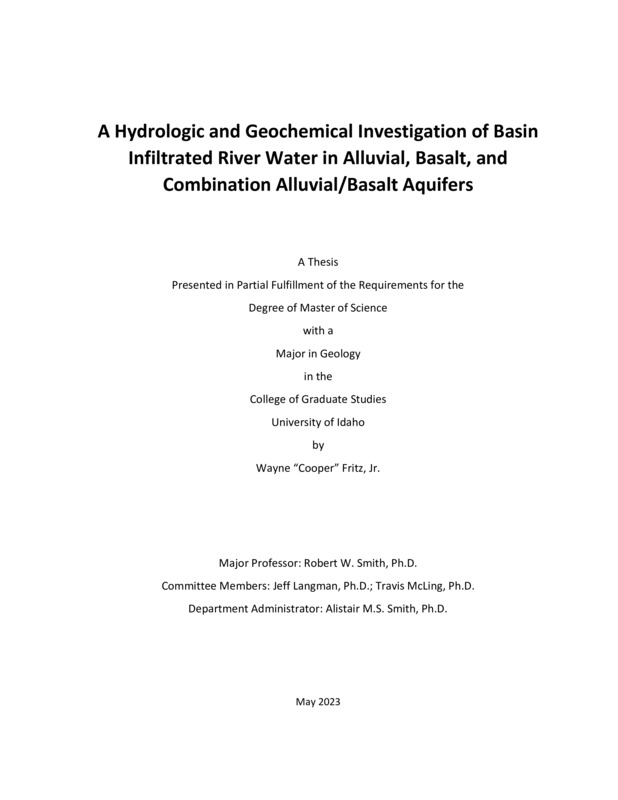A Hydrologic and Geochemical Investigation of Basin Infiltrated River Water in Alluvial, Basalt, and Combination Alluvial/Basalt Aquifers
Fritz, Cooper. (2023-08). A Hydrologic and Geochemical Investigation of Basin Infiltrated River Water in Alluvial, Basalt, and Combination Alluvial/Basalt Aquifers. Theses and Dissertations Collection, University of Idaho Library Digital Collections. https://www.lib.uidaho.edu/digital/etd/items/fritz_idaho_0089n_12500.html
- Title:
- A Hydrologic and Geochemical Investigation of Basin Infiltrated River Water in Alluvial, Basalt, and Combination Alluvial/Basalt Aquifers
- Author:
- Fritz, Cooper
- Date:
- 2023-08
- Program:
- Geography & Geological Science
- Subject Category:
- Geochemistry; Hydrologic sciences; Water resources management
- Abstract:
-
Groundwater overdraft is a persistent problem in the western US including in the East Snake River Plain (ESRP) Aquifer (ESRPA), the largest in Idaho. Managed aquifer recharge (MAR) is a tool increasingly utilized for stabilizing aquifer storage volumes and is employed across the ESRP to infiltrate untreated river water through constructed recharge basins. Hydrologic and water quality data from monitoring well networks in the vicinity of three ESRP MAR basins – one each in an alluvial, basalt, and combination alluvial/basalt setting, together representative of the ESRPA – were examined. Processes investigated were hydrologic mixing between ambient groundwater and infiltrated water and whether cation exchange and calcite precipitation/dissolution reactions impacted MAR water. In addition, groundwater level increases and decreases in response to infiltration events were investigated as to whether they indicated the arrival and departure of MAR water at a pumping location. The results also provide suggestions regarding the location of hydrologic and chemical monitor well placement as MAR programs continue to evaluate new sites. A sample analysis provided results consistent with the stratification of infiltrated and ambient groundwater at all three sites. In the alluvial and basalt settings some sampling locations were entirely infiltrated water while at the combination alluvium/basalt setting vertical stratification in the aquifer was inferred. Hydrologic responses to basin inflow events in wells chemically unimpacted by MAR water indicated that water table responses did not necessarily evidence the arrival or departure of infiltrated water but could be the result of a “mound” of infiltrated water growing under the basins that displaced ambient groundwater away from it. At the alluvial site an analysis of samples indicated that reverse cation exchange impacted infiltrated water, but calcite precipitation (if it occurred) did not impact infiltrated water chemistry. Geochemical modeling predicted that the reverse cation exchange processes would continue with increased alluvium interaction, but that calcite precipitation would have a nondetectable impact on the chemistry of infiltrated water and in any case would not be discernable from an analysis of the samples because much of the calcium precipitated as calcite would have been derived from reverse cation exchange. All wells, located between 620 ft (190 m) downgradient and 100 ft (30 m) cross gradient, were chemically impacted by infiltrated water (primary infiltration event average of 24.8 AF [30,590 m3] per day for 54 days) suggesting that these are appropriate distances for chemical monitor wells. However, local heterogeneities in the flow field played a larger role in the movement of infiltrated water than simple distance from the basin. At the basalt site, fracture flow governed hydrologic and chemical impacts. Two distant (greater than 5,280 ft [1,609 m]) locations showed no chemical interactions between the aquifer matrix and infiltrated water. At a third location cation exchange processes may have impacted the samples. The three wells chemically impacted by infiltrated water were within 600 ft (183 m) of the basin while the other locations, 5,280 ft (1,609 m) or greater, were hydrologically impacted but showed no evidence of infiltrated water possibly because preferential flow paths routed the high volumes (primary infiltration event average of 730 AF [900,440 m3] per day for 133 days) away from the wells. Together these results suggest a range in which chemical monitor wells might be located but also demonstrate the significance of flow field heterogeneity. At the combination alluvium/basalt site, wells were located 1,250 ft (380 m) cross gradient and 6,750 ft (2,060 m) downgradient and were not chemically impacted by the basin (infiltration event average of 88.3 AF [180,900 m3] per day for 136 days) suggesting that these locations are too distant to be appropriate for chemical monitoring. Hydrologic responses to infiltration events were observed only in the closer location.
- Description:
- masters, M.S., Geography & Geological Science -- University of Idaho - College of Graduate Studies, 2023-08
- Major Professor:
- Smith, Robert
- Committee:
- McLing, Travis L. ; Langman, Jeffery; Smith, Alistair
- Defense Date:
- 2023-08
- Identifier:
- Fritz_idaho_0089N_12500
- Type:
- Text
- Format Original:
- Format:
- application/pdf
- Rights:
- In Copyright - Educational Use Permitted. For more information, please contact University of Idaho Library Special Collections and Archives Department at libspec@uidaho.edu.
- Standardized Rights:
- http://rightsstatements.org/vocab/InC-EDU/1.0/

